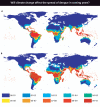Dengue reborn: widespread resurgence of a resilient vector
- PMID: 18795135
- PMCID: PMC2535648
- DOI: 10.1289/ehp.116-a382
Dengue reborn: widespread resurgence of a resilient vector
Figures







Comment in
-
Dengue transmission.Environ Health Perspect. 2009 Feb;117(2):A56. doi: 10.1289/ehp.0800227. Environ Health Perspect. 2009. PMID: 19270769 Free PMC article. No abstract available.
Publication types
MeSH terms
LinkOut - more resources
Full Text Sources
Medical
